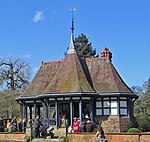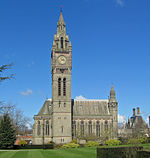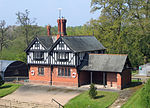Eaton Hall is the country house of the Duke of Westminster. It is 1 mile (2 km) south of the village of Eccleston, in Cheshire, England. The house is surrounded by its own formal gardens, parkland, farmland and woodland. The estate covers about 10,872 acres (4,400 ha).The first substantial house was built in the 17th century. In the early 19th century it was replaced by a much larger house designed by William Porden. This in turn was replaced by an even larger house, with outbuildings and a chapel, designed by Alfred Waterhouse. Building started in 1870 and concluded about 12 years later. By 1960 the fabric of the house had deteriorated and, like many other mansions during this period, it was demolished, although the chapel and many of the outbuildings were retained. A new house was built but its design was not considered to be sympathetic to the local landscape, and in the late 1980s it was re-cased and given the appearance of a French château.
The house has been surrounded by formal gardens since the 17th century, the design of which has changed over the centuries in accordance with contemporary ideas and fashions, as has the surrounding parkland. A variety of buildings are included in the estate, some decorative, others built for the business of the estate; many of these are listed buildings. The house and estate are not normally open to the public, but the gardens are open on three days a year to raise money for charity, and some of the estate's buildings can be hired for charitable purposes.










